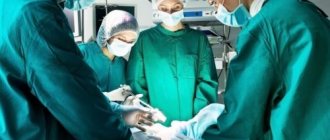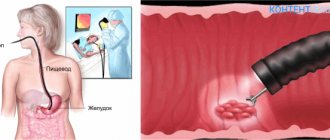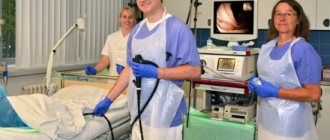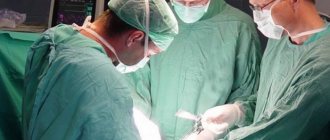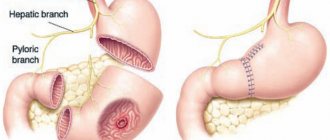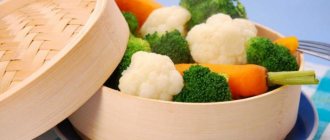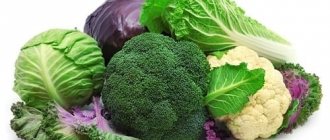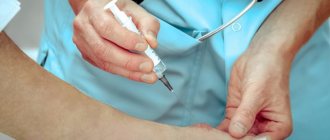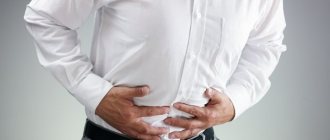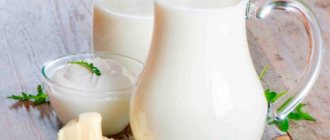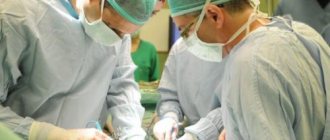Surgery for stomach ulcers is performed in severe cases of the disease.
It is carried out both on a planned and urgent basis. The main indications for it are often special circumstances. This disease has an ICD code K25. It is quite common all over the world. Every tenth person suffers from it. Males are predominantly affected. Usually the pathology is treated with therapeutic methods. However, it has a chronic course with periods of exacerbation and attenuation of symptoms. When medications are ineffective, surgery is often used.
Surgery for stomach ulcers
Treatment of such a disease is very long and difficult. Most often, it is carried out with the help of pharmacological drugs, but every second patient needs surgical intervention.
Since the pathology occurs with frequent and severe exacerbations, the patient’s well-being and general health gradually deteriorate rapidly. Sometimes the situation takes such a threatening turn that surgery to remove a stomach ulcer is carried out urgently.
Indications for surgery for stomach ulcers
The main medical reasons for surgical intervention are the complete ineffectiveness of therapeutic methods of treatment, the presence of obvious contraindications to taking medications, or a sharp deterioration in a person’s general well-being.
One of the direct reasons for surgical intervention is the risk of perforation and heavy internal bleeding. It most often occurs as a complication when using certain pharmacological agents.
Doctors also attach great importance to the age category. The older a person is, the more various concomitant diseases he usually has. Typically, surgery is performed when the patient's health suffers so much that there is an immediate threat to his life.
Rehabilitation, how long do they stay in the hospital?
After surgery, long-term treatment with antiulcer drugs is required. In the first 3 days, it is forbidden to eat food or drink any liquids.
All nutrients are administered to the patient through the veins using a dropper. The patient is on bed rest, but from the second day after the intervention you can do breathing exercises, which are taught by nurses in the hospital.
Diet therapy, which is prescribed to ulcer sufferers for the rest of their lives, is very important after surgical treatment of peptic ulcer disease.
- From about 4-5 days, the patient begins to be given broths and jelly, pureed vegetable soups and semolina, cottage cheese and pureed lean meat.
- Meals need to be organized in fractional, small portions, 6 times a day.
- The basis of the diet is steamed or boiled semi-liquid dishes.
- Patients must chew each piece thoroughly.
- The temperature of the food consumed should not exceed 50-55 degrees, but cold food with a temperature below 15 degrees should not be eaten either.
- You can eat steamed omelettes and soft-boiled eggs, cod and oatmeal broth. It is recommended to drink jelly and rosehip decoction.
Fried and smoked, fatty and spicy, canned foods, foods with a lot of fiber (white cabbage, turnips, radishes, etc.) are prohibited for ulcer sufferers. It is better to eat fruits after heat treatment in the form of compote or fruit jelly.
Preparing for surgery
If surgery for a stomach ulcer is required urgently, then the patient is simply prepared for emergency surgery, which is performed under general anesthesia.
When planned treatment is prescribed, it is first necessary to conduct a gastroendoscopy, ultrasound scan, computed tomography, radiography with contrast, study of the condition of the abdominal organs, gastric histological examination, electrocardiogram, etc.
In addition, the patient must provide the results of a clinical and biochemical blood test. It is also necessary to confirm the fact of excluding sexually transmitted infections, as well as hepatitis, HIV and syphilis, and also make a smear on the microflora of the genital secretions. Determination of blood group and Rh factor, a detailed coagulogram and a general urine test are required.
If any serious illness is detected, you should consult with:
- gynecologist;
- dermatologist;
- cardiologist;
- pulmonologist;
- therapist;
- urologist;
- phlebologist;
- endocrinologist.
In the presence of acute or chronic infectious processes, their complete preliminary cure is necessary. Particular attention should be paid to inflamed tonsils, sinusitis or carious teeth.
Indications
Indications for surgical treatment of peptic ulcer have absolute or indirect significance. Absolute indications for surgery are conditions like:
- Perforation of an ulcerative lesion into the abdominal cavity;
- Intense and difficult to stop bleeding;
- Penetration, in which the ulcerative formation spreads to adjacent tissues and walls of nearby organs;
- Narrowing of the muscular outlet valve of the gastric pylorus;
- Long-term non-healing ulcerative formation with suspected malignancy.
Typically, indications for intervention in this case are frequent pathological relapses or the callous nature of the lesion, bleeding that is difficult to stop, the risk of complications, or the healing of ulcerative lesions with any complex defects.
Most often today, in case of ulcerative pathology of the gastric organ, suturing or resection of the stomach is performed. And in case of ulcerative pathology of the duodenum, vagotomy is indicated.
Progress of the operation
The main stages of surgery for a gastric ulcer vary depending on its type. In any case, it is performed under general endotracheal anesthesia.
The patient's abdominal cavity is opened along the midline, starting from the sternum and ending with the umbilical region. Then the organ is completely mobilized. After this, the main arteries and veins affected during the operation are ligated. Otherwise, the wound surface will bleed heavily.
Following the surgeon's manipulations, the stomach and duodenum are sutured with a special suture. Then one of the types of manipulation chosen by the doctor is performed.
Types of surgical treatment of peptic ulcer
Most often used for this disease:
- vagotomy;
- resection;
- suturing;
- laparoscopic method.
Vagotomy
This type of operation is characterized by the fact that it cuts out the nerves leading to the gastric mucosa, which synthesizes excess amounts of enzymes and a substance that regulates digestion, called gastrin.
The organ itself does not suffer. Traumatic intervention in its structures is not carried out, and the threat of perforation completely recedes.
Sometimes the entire nerve trunk is resected. But more often only partial (selective) removal of nerves is performed. Subsequently, many complications can be avoided. Then the ulcer heals very quickly. However, after surgery the functioning of the gallbladder and pancreas is often disrupted.
In addition, the abdominal cavity requires mandatory drainage, since after surgery the patient often suffers from congestion.
Resection
When a stomach ulcer is diagnosed, organ resection surgery is performed quite often. It is usually performed when there is a risk of perforation and is performed for urgent indications.
Surgery is usually performed endoscopically. An abdominal microincision is made along the linea alba. Most often, the area directly affected by the ulcer is excised, but sometimes the entire organ is removed.
After the surgical process is completed, the surgical field is sutured with self-absorbing threads, and the greater omentum is sewn to the resulting wound. Then drainage and complete disinfection of the abdominal cavity occurs. A probe remains in the hole to evacuate the exudate.
Palliative suturing
Suturing a gastric ulcer is usually carried out when there is a direct threat of severe complications. It is usually performed when there is a clear risk of perforation.
The abdominal cavity is opened and the contents of the organ are aspirated. Then the surgeon carefully examines his condition and finds the exact place where the ulcer is closest to perforated.
It is this point that is sutured by the surgeon using a seromuscular suture. It is applied across the center line. Manipulation makes it possible to completely prevent the formation of adhesions and narrowing of the lumen of the pyloric part of the stomach.
It should be borne in mind that palliative suturing is often fraught with very serious complications.
Laparoscopy
This type of surgery is very popular due to its low invasiveness.
A micro-incision is made in the abdomen and special endoscopic equipment is inserted into it. Then special medical instruments are used. The progress of the manipulation is monitored on the monitor screen.
Most often, stomach ulcers are cauterized using a laser. The intervention is so minimally traumatic that it is performed under local anesthesia. In other cases, the internal walls of the organ and duodenum are sutured. Sometimes, if there is a small ulcer, partial resection is performed.
Allowed drinks and foods, methods of cooking, postoperative diet rules
Diet after surgery is an important part of the patient's recovery, which affects a quick recovery. A gentle diet is primarily aimed at restoring the normal functioning of the stomach and sparing it as much as possible.
After surgical treatment, the patient can eat:
- only boiled food;
- dishes should be served in grated or semi-liquid form;
- light and at the same time nutritious food;
- food at room temperature. It is strictly forbidden to eat extremely hot or extremely cold foods;
- products enriched with easily digestible proteins, fats and carbohydrates.
It is recommended to eat small meals frequently, up to eight times a day.
The diet expands slightly two weeks after surgical treatment. You should find out what foods you can eat from your doctor - he will provide a complete list of prohibited and permitted food ingredients.
Often, following a diet lasts no more than two months, but it is worth considering that throughout your life you will need to give up fatty and spicy foods, alcoholic and carbonated drinks.
If the operation is performed in a timely manner, all recommendations regarding nutrition are followed and a healthy lifestyle is maintained, the prognosis for stomach ulcers is favorable.
The first two weeks after gastric surgery with a complication of an ulcer in the form of a perforation is a particularly important period; the diet is strictly adhered to, without overeating or exceeding the norm of permitted foods. Excessive stress on weakened digestive organs will cause a protracted recovery period. The damaged epithelium is weak at first, so the food should be neutral, non-aggressive, so that the mucous membranes begin to recover.
Products are selected in accordance with the dietary table number and their tolerance. The basic principle is that they do not cause excessive release of hydrogen chloride and are easily digestible. The temperature for serving hot first and second courses is 50 degrees, cold - 30-40 degrees.
Food is consumed in small portions, in accordance with the number of the recommended dietary table, from six to eight times a day.
A sample menu after surgery for a perforated gastric or duodenal ulcer includes gentle, carefully selected and properly prepared foods. 5-6 meals a day in small portions are organized.
https://www.youtube.com/watch?v=w8RxI47fXwU
All products are prepared:
- steamed;
- boil;
- baked;
- or stewed.
For easy digestion, food should be liquid, semi-liquid, very soft or pureed. Also, it facilitates the work of the digestive organs by following the rules of separate nutrition, when one product or certain types of products are consumed at one meal, and others at another.
Postoperative nutrition includes the following drinks, foods, and dishes:
- green, herbal teas;
- milk (tea with milk);
- fruit drink, compote;
- jelly;
- porridge with milk or water (oatmeal, or pureed buckwheat, rice, semolina);
- soft-boiled eggs without oil, steamed omelet;
- light vegetable soups, cream soups;
- milk soups;
- pureed vegetables (pumpkin, potatoes, carrots);
- skim milk, cottage cheese, sour cream and other non-acidic dairy products;
- dietary meat (chicken, rabbit, turkey), broths from them;
- steamed cutlets and zrazy from dietary meat, fish or vegetables;
- lean fish;
- low-fat cheeses;
- fruit jellies;
- soufflés, mousses from permitted products;
- homemade pate;
- dried premium bread, biscuits.
Tea can be sweetened a little, preferably with honey.
For seafood, cod, hake fillet, gobies and other dietary fish are suitable. During the first time after surgery, fresh vegetables and fruits are not included in the patient’s diet. But their subsequent use will contribute to faster rehabilitation of the patient.
In order not to provoke increased secretion of the stomach, fruits should not be sour and rough. You can eat bananas, pears, melons, and sweet apples. Soups and purees can be prepared using potatoes, carrots, pumpkin, zucchini, and beets.
Oatmeal, rice, and buckwheat porridge occupy a large place in the diet after surgery for a perforated stomach or duodenal ulcer. For desserts, you can have various jellies, soufflés, and mousses made from permitted products.
Since fresh baked goods are prohibited, bread is consumed dried. The use of a small amount of natural vegetable oil or butter is allowed. The permissible salt intake is up to 6 grams per day.
The rules of postoperative nutrition relate not only to the correct selection of products, but also to the regimen. It consists of 5-6 meals a day in small portions. Such crushing also reduces the load on the mucous membranes and prevents dangerous stretching of their cavities, especially in the first time after surgery.
Based on the above, the diet for a perforated gastric or duodenal ulcer is formed in accordance with the following rules:
- using only approved products and cooking methods;
- small meals (6 times a day);
- It is unacceptable to overeat and drink large amounts of liquid at once;
- food should be warm, within 15-60°C;
- food should be soft (liquid, semi-liquid, puree);
- You need to chew food thoroughly to grind it and soak it with saliva.
To comply with all dietary standards, the most convenient option is home cooking.
During the two postoperative months, the patient must adhere to a strict diet. Compliance with all medical rules and recommendations will avoid relapse of the disease and the development of the inflammatory process. For a speedy recovery, adhere to the principles of a healthy diet.
After surgery to remove a stomach ulcer, the patient must remember the rules to restore his condition:
- Not to starve. Abstinence from food for medicinal purposes is permissible only for the first three days after the intervention. You need to eat at least 6 times a day in small portions. The optimal weight of one is 200 g.
- You can only eat home-cooked food. This means that industrial sweets, sausages, cheeses, canned food and sugary soda are completely removed from the diet.
- Spicy dishes and marinades pose a danger to the mucous membrane, irritating it. Even garlic, which is so beneficial for the body, should be excluded from the menu, since it is a natural irritant and also provokes the release of acids. Restrictions also apply to table salt, which is better replaced with sea salt.
- Eating after surgery involves grinding solid food into a puree. For example, boiled vegetables can be blended using a blender.
- Doctors prohibit cooking food with added oil or animal fats to avoid complications. In general, after gastric surgery, the diet should consist of steamed or oven-cooked dishes that do not cause irritation of the mucous membrane.
- Observe temperature conditions. Do not allow foods that are too hot or cold, as a sharp change will negatively affect the condition of your epigastrium.
Doctors will provide you with a complete list of products for consumption in the postoperative period.
What is allowed
After gastric surgery, the patient is prescribed a strict diet, which he must follow for at least a year. You can try any of your favorite treats only starting from the second postoperative year.
So, doctors allow the following products:
- omelet and steamed eggs;
- dietary meat (turkey, chicken and beef);
- low-fat dairy products;
- vegetables (potatoes, pumpkin, carrots, zucchini);
- fruits (apples, pears, bananas);
- cereals (oatmeal, rice, buckwheat, pasta).
A menu that includes this food will give the patient strength and energy for a speedy recovery.
What is prohibited
During the period after perforation, the patient should not consume a number of foods that will negatively affect his condition and create discomfort in the stomach and intestines. The list of prohibited foods includes:
- bakery products, muffins;
- legumes;
- any sauces;
- sweets, nuts and seeds;
- preservation, marinades;
- seasonings, spices;
- semi-finished products;
- fried and fatty foods.
Peptic ulcers completely exclude products that contain cocoa.
Also during the recovery period, and in later life, you should give up smoking and other bad habits.
Possible complications
If the surgical intervention was successful and the danger facing the patient was eliminated, then he should still be under the supervision of a specialist.
Monitoring his condition is required in order to avoid serious consequences, which may include:
- dumping syndrome;
- adductor loop syndrome;
- disruption of the synthesis of digestive enzymes and hormones;
- reflux gastritis;
- changes in metabolism;
- enteritis, etc.
Consequences
Although surgical treatment of peptic ulcer is carried out for special indications, it can be complicated by some unpleasant conditions. Immediately after surgery, patients may experience bleeding, inflammation, or suture dehiscence.
Later complications include:
- Dumping syndrome, in which food entering the stomach passes through it too quickly and unprocessed enters the intestines;
- Reflux gastritis of the alkaline type, in which food masses from the duodenum are thrown back into the gastric cavity, which irritates and damages the mucous membranes, provoking the development of gastritis in the resected gastric organ;
- The adductor colon, which is a complication of gastric resection, is manifested by evacuation disorders of intestinal functions;
- Anemia or intestinal dyspepsia syndrome, secondary pancreatitis and hernia processes, adhesions, etc.
Postoperative period
After successful surgery to treat a stomach ulcer, the patient requires strict bed rest. Nutrition is provided only parenterally.
After the operation has been successfully performed, a stomach ulcer can still make itself felt in the postoperative period. Therefore, antibacterial drugs, wound healing agents, anti-inflammatory substances, immunostimulants, sedatives, etc. are prescribed.
If everything proceeds in accordance with the treatment plan, then after four days the drainage is removed, and after a week the sutures are removed.
The patient is discharged to work only after complete recovery, which can take up to two months. In the presence of severe complications, among which the development of peritonitis stands out, surgical intervention is sometimes performed again.
Recovery period after the procedure
Since important vital functions were affected during the manipulation, the person needs care and compliance with the doctor’s instructions. If surgery was performed on a stomach ulcer, how long does the postoperative period last? This depends on the success of the manipulation and the dynamics of recovery, as well as the formation of complications. Under the most favorable circumstances, the patient can be discharged within 7-10 days, but sometimes a person leaves the hospital after 2 weeks.
After surgery you will need a therapeutic diet
If part of the stomach is removed, the functionality of eating food will remain, but will be slightly limited. In the case of complete excision of an organ, the formation of reflux of food or the development of a serious and irreversible consequence incompatible with life is sometimes observed. At this time, it is important to eat properly, using medications and diet, which will help reduce the acidity of the stomach fluid. This condition allows you to reduce the healing time.
After the operation, the patient must be registered and monitored very carefully for a long time.
On the first day after the procedure, the person is given neither water nor food, but the body is saturated by intravenous drip. Next on the list of available dishes are foods that do not irritate the walls of the organ. As a result, the patient is advised to remain on a strict diet for a year.
You need to eat foods that do not damage the mucous membranes
Prevention of complications
In order to avoid the serious consequences of surgery for stomach ulcers, you need to follow the rules of prevention.
Primary measures include medical methods to prevent the development of complications. Secondary include:
- Prevention of infection.
- Dieting.
- Refusal of a number of products.
- Fractionality of nutrition.
- Eating easily digestible foods.
- Prohibition on smoking and drinking alcoholic beverages.
- Preventing the feeling of hunger.
- Limiting nervous situations.
Cost of the operation
If you have a compulsory health insurance policy, surgery for stomach ulcers is carried out free of charge.
If it is absent or the patient prefers to be treated in a private clinic, then the cost usually includes the level of qualifications of the doctor performing the operation, the degree of complexity of the manipulations performed and the level of equipment used.
As a rule, vagotomy, resection, suturing or laparoscopy are performed for a fee. Most often, they cost the patient about twenty thousand rubles. But you cannot save on your health. Therefore, you should find out whether the medical center has all the required licenses and certificates, the presence of an experienced specialist on staff, the level of training of nursing staff, the provision of pharmacological drugs, the quality of equipment in the operating room, the possibility of staying in a hospital, etc.
Therefore, usually an institution that meets all basic wishes will ask for no less than forty to seventy thousand rubles for its services. Provided that all requirements for the quality of medical services are met, full rehabilitation and medical supervision of the patient until complete recovery is carried out, the price is not too high.
Nutrition rules
After the operation, the patient adheres to the following rules:
- Solid food should be excluded from the diet for about two months. Even a small piece can get into the abdominal cavity, and to remove it it will be necessary to do another operation, since even a probe will not help in this case.
- The ideal dish is one that does not contain fast carbohydrates, cholesterol, spices, large pieces and carcinogens. That is, the ingredients of a dish, when digested, should not prompt the digestive organs to secrete excessive amounts of enzymes.
- The size of one serving should be about the size of a fist. If it turns out to be larger, the stomach simply cannot cope with the task, which can cause a relapse.
- You should always take food at the same time. Thanks to this, the stomach gets used to producing digestive enzymes at a certain time. In addition, it is very important to maintain the same interval between meals. The maximum interval between them should be three hours. If it is less, then the organs may not have time to cope with the previous portion. If it turns out to be larger, then self-digestion can be caused. The fact is that against the background of a long absence of food, the stomach still secretes digestive enzymes that corrode its mucous membrane.
- Should you cook only by steaming and can you bake dishes in the first two months after surgery? The answer to these questions is one - undesirable. Even baking food during the first month after surgery is not recommended. You will also have to give up raw fruits and vegetables for at least one to two months.
Not everyone knows what you can eat after stomach ulcer surgery.
